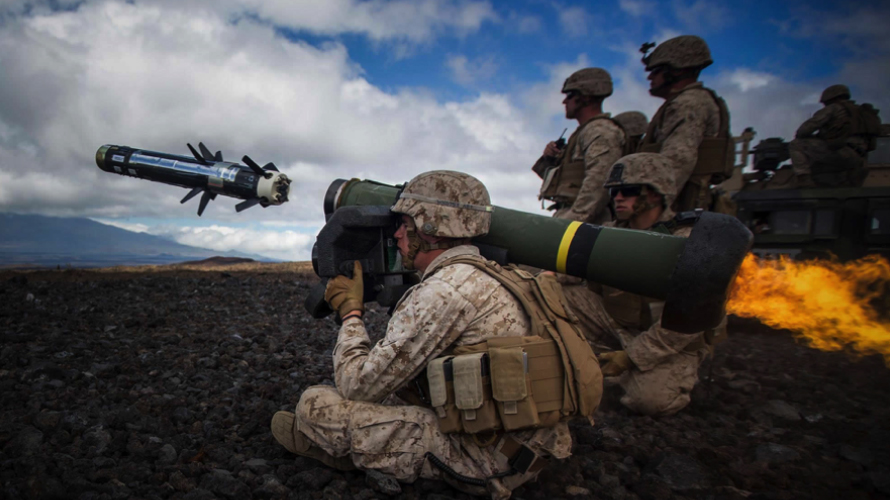
Marines train with the Javelin anti-tank missile (USMC)
WASHINGTON — Development and flight testing of the Army’s future Javelin G-model has been paused for months following a test failure last year — and will remain paused indefinitely, as the service has yet to identify the cause of the issue, Breaking Defense has learned.
Lockheed Martin and Raytheon’s Javelin Joint Venture is under contract to develop the new missile, to be formally designated the FGM-148G, that includes a new disposable launch tube assembly, electronic battery unit, guidance electronics unit, and missile seeker. But testing ground to a halt last year when a missile “experienced a failure” during a contractor-led confidence flight, the Director of Operational Test and Evaluation (DOT&E) revealed in the annual report released last month.
In response to questions, the Army this week confirmed that an investigation is still underway to figure out what caused the anomaly and testing has not resumed.
“The Army is actively pursuing a root cause identification in coordination with the contractor,” a spokesman for the Program Executive Office (PEO) for Missiles and Space wrote in an email on Thursday. “Initial review has identified likely contributors to the anomaly, but further investigation is required to validate the root cause and provide a corrective action.”
The Army spokesman did not provide additional details about the nature of the test failure and spokespeople for the joint venture did not immediately respond to Breaking Defense’s questions. However, the Army said that as soon as corrective actions are implemented and verified through follow-up testing, the testing program will resume. New missile development is expected to continue over the next three years and if the Army deems qualification testing as a success, then production will begin, according to the DOT&E report.
The Army spokesman also noted that Javelin G-model testing delays are not affecting plans to ramp up Javelin production of earlier versions of the missile, an initiative underway to support Ukraine’s military with the shoulder-launched weapon and refill US stockpiles.
Javelin G-model development is one part of the Army’s Javelin Antitank Missile System – Medium upgrade effort for a man-portable, shoulder-launched, fire-and-forget system designed to strike armored vehicles out to 2,500 meters. The second line of effort involves the development of a reusable Lightweight Command Launch Unit (LW CLU), which appears to be going more smoothly than the Javelin effort.
“The CLU mechanically engages the [launch tube assembly] for shoulder firing, has day and night sights for surveillance and target acquisition, and electronically interfaces with the missile for target lock-on and missile launch,” DOT&E explained in its publicly available fiscal 2022 report on weapon development programs.
According to the DOT&E report, the LW CLU incorporates “modern” daylight and infrared camera technology in a smaller and lighter form factor, and it will be compatible with the G-model missile and previous iterations too.
Efforts to equip Ukrainian forces with the shoulder-launched weapon have “accelerated production of the LW CLU,” the Army spokesman said. He noted that the service wants to make a production decision around the January-March 2024 timeframe in order to begin fielding the new LW CLU in fiscal 2025. Although development of the Javelin G-model and LW CLU are linked, each is not dependent on the other since the LW CLU can fire legacy missiles and the Javelin G-model can be fired from legacy launchers.
Leading up to that decision point, the service plans to conduct two operational tests this year – one at its Cold Region Test Center in Ft Greely, Alaska and another at Yuma Proving Grounds, Ariz.
So far though, DOT&E said the LW CLU’s “better camera resolution and higher zoom capability” enables it to better detect, recognize, and identify “threat vehicles” quicker and, possibly, at greater distances than the older Block 1 CLU.
“Feedback on the LW CLU has been positive,” the report said. “Gunners prefer the improved camera resolution and the smaller, lighter form factor. [Developmental] testing to date indicates that the LW CLU is on track to meet its reliability requirement.”
Army eyes TBI monitoring, wearable tech for soldiers in high-risk billets
“We are also looking at what additional personal protective equipment we can provide to our folks, especially instructors and others who are routinely exposed to blast pressure,” said Army Secretary Christine Wormuth.


























